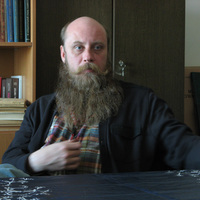
Anu Lahtinen
University of Helsinki, Department of Philosophy, History, Culture and Art Studies, Professor of Finnish and Nordic History
Address: Finnish History
Historicum
Sirkkala
FIN-20014 UNIVERSITY OF TURKU
Historicum
Sirkkala
FIN-20014 UNIVERSITY OF TURKU
less
Related Authors
Terry Gunnell
University of Iceland
Alejandra B Osorio
Wellesley College
Andrea Peto
Central European University
David Seamon
Kansas State University
J. H. Chajes
University of Haifa
Fjodor Uspenskij
Vinogradov Russian Language Institute
Florin Curta
University of Florida
Francisco de Paula Souza de Mendonça Júnior
UFSM - Universidade Federal de Santa Maria
Seda Pekşen
Ankara University
Stephen Whittle
Manchester Metropolitan University
InterestsView All (10)










Uploads
Papers by Anu Lahtinen
The volume investigates customary beliefs, social practices and values related to death and dying in medieval and early modern Europe. The articles touch upon the legislation and teachings, but also emotions and coping strategies related to death and dying. Whether analyzing the remembrance of death or burials of outlaws, articles give new insights into the transitions from pre-Christian era to Christianization and from the medieval Catholic period to the Reformation era.
As several authors point out, old concepts and practices were negotiated and given a new context: medieval texts and common habits could be revised to serve the new doctrines. The social functions of rituals and customs helped to preserve them regardless of religious changes, and as the articles in the volume indicate, parallel cultures and customs prevailed from medieval to early modern times.
Contents
Cultures of Death and Dying in Medieval and Early Modern Europe: An Introduction
Mia Korpiola and Anu Lahtinen
The Remembrance of the Deceased in the Traditional Polish Culture of the Middle Ages
Beata Wojciechowska
Deviant Burials: Societal Exclusion of Dead Outlaws in Medieval Norway
Anne Irene Riisøy
Parental Grief and Prayer in the Middle Ages: Religious Coping in Swedish Miracle Stories
Viktor Aldrin
Transforming the Investment in the Afterlife: Readings of the Poem De Vita Hominis
in Pre-Reformation and Post-Reformation Denmark
Eivor Andersen Oftestad
Dicing towards Death: An Oracle Game for Miners at the Falun Copper Mine from the Early Seventeenth Century
Iris Ridder
“To Help the Deceased Guild Brother to His Grave”: Guilds, Death and Funeral Arrangements in Late Medieval and Early Modern Norway, ca. 1300–1900
Håkon Haugland
Post-Mortem – an Afterword
Ditlev Tamm
COLLeGIUM is a scholarly, open-access journal published by the Helsinki Collegium for Advanced Studies. All journal articles published in COLLeGIUM are internationally refereed.
For more information, please visit http://www.helsinki.fi/collegium/journal.
(see http://www.ennenjanyt.net/?p=700) deals with property disputes between the residents of the Sundholm Manor and the neighbouring villages in 16th-century Kalanti (Finland).[1] There were lengthy disputes over the ownership of some landed property and fishing waters. Although the court verdicts favoured the owners of the Sundholm Manor and the farmers standing on their side, the other party ignored the verdicts to a large extent and continued using the property rather than obeying the verdict given by the court.[2] The article analyses the process of one specific property dispute and concludes that in a way, no final solution was made; shifting power balance in the local community, such as the manor owner’s death, often brought the parties back to the starting point of the dispute. Any court rulings were valid only in so far as they were honoured by both parties.
The article is also a pilot project testing the new PID system of the Finnish National Archives Service.[3] Archival sources that were used for testing PID tools were the Archives of the Sundholm Manor (Sundholman kartanon arkisto) and the Bailiff’s Records, more precisely the Land Register (Maakirja) for the year 1540. For more information in Finnish, please see the information provided by the National Archives Service at http://www.arkisto.fi/fi/arkistolaitos/tehtavat/tutkimus/laehdeviitepalvelu
The volume investigates customary beliefs, social practices and values related to death and dying in medieval and early modern Europe. The articles touch upon the legislation and teachings, but also emotions and coping strategies related to death and dying. Whether analyzing the remembrance of death or burials of outlaws, articles give new insights into the transitions from pre-Christian era to Christianization and from the medieval Catholic period to the Reformation era.
As several authors point out, old concepts and practices were negotiated and given a new context: medieval texts and common habits could be revised to serve the new doctrines. The social functions of rituals and customs helped to preserve them regardless of religious changes, and as the articles in the volume indicate, parallel cultures and customs prevailed from medieval to early modern times.
Contents
Cultures of Death and Dying in Medieval and Early Modern Europe: An Introduction
Mia Korpiola and Anu Lahtinen
The Remembrance of the Deceased in the Traditional Polish Culture of the Middle Ages
Beata Wojciechowska
Deviant Burials: Societal Exclusion of Dead Outlaws in Medieval Norway
Anne Irene Riisøy
Parental Grief and Prayer in the Middle Ages: Religious Coping in Swedish Miracle Stories
Viktor Aldrin
Transforming the Investment in the Afterlife: Readings of the Poem De Vita Hominis
in Pre-Reformation and Post-Reformation Denmark
Eivor Andersen Oftestad
Dicing towards Death: An Oracle Game for Miners at the Falun Copper Mine from the Early Seventeenth Century
Iris Ridder
“To Help the Deceased Guild Brother to His Grave”: Guilds, Death and Funeral Arrangements in Late Medieval and Early Modern Norway, ca. 1300–1900
Håkon Haugland
Post-Mortem – an Afterword
Ditlev Tamm
COLLeGIUM is a scholarly, open-access journal published by the Helsinki Collegium for Advanced Studies. All journal articles published in COLLeGIUM are internationally refereed.
For more information, please visit http://www.helsinki.fi/collegium/journal.
(see http://www.ennenjanyt.net/?p=700) deals with property disputes between the residents of the Sundholm Manor and the neighbouring villages in 16th-century Kalanti (Finland).[1] There were lengthy disputes over the ownership of some landed property and fishing waters. Although the court verdicts favoured the owners of the Sundholm Manor and the farmers standing on their side, the other party ignored the verdicts to a large extent and continued using the property rather than obeying the verdict given by the court.[2] The article analyses the process of one specific property dispute and concludes that in a way, no final solution was made; shifting power balance in the local community, such as the manor owner’s death, often brought the parties back to the starting point of the dispute. Any court rulings were valid only in so far as they were honoured by both parties.
The article is also a pilot project testing the new PID system of the Finnish National Archives Service.[3] Archival sources that were used for testing PID tools were the Archives of the Sundholm Manor (Sundholman kartanon arkisto) and the Bailiff’s Records, more precisely the Land Register (Maakirja) for the year 1540. For more information in Finnish, please see the information provided by the National Archives Service at http://www.arkisto.fi/fi/arkistolaitos/tehtavat/tutkimus/laehdeviitepalvelu